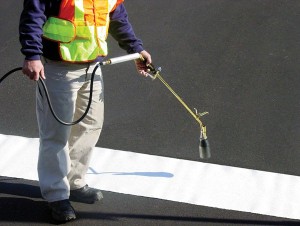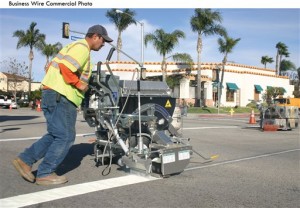Preformed thermoplastic and Machine applied thermoplastic both have advantages and disadvantages. Each excels in certain applications. The actual composition of each is very close although preformed generally contains a few extra ingredients.
Preformed Thermoplastic
Preformed thermoplastic is created in a factory controlled environment using alkyd resins, special polymers and additives introduced to enhance the final product. Because of this the quality is high and consistent. When applying preformed thermoplastic the surface is either warmed to dry it or heated to a higher temperature as part of the installation process. In both cases the drying process removes any moisture issues creating a more dependable bond. Since preformed applications are generally smaller the application area is more likely to be cleaned when the product is applied. This also improves the bond. Letters and logos can be applied with no stencil required and because glass beads are already in and on the material, additional glass beads are not required. Both of these features save time.
Overall, preformed thermoplastic is ideal for smaller jobs where it is not cost effective or desirable to have a large crew and expensive equipment on site. What a crew with $200,000 in equipment could do at an intersection with machine applied thermoplastic, one man could do with preformed thermoplastic and a torch. The clean up for a preformed job is almost no issue. Just throw away the boxes the thermoplastic came in and put up your torch.
One last consideration is that preformed seems to do better on cement and concrete surfaces. This is mostly due to the formulation of the product.
Pros of Preformed –
- Quick and easy to apply
- Small crew needed.
- High success rate on asphalt and concrete
- Consistent quality and color
- Glass beads already in the product
- No stencils required
- Available with non skid built in
Cons of Preformed –
- Expense per linear foot
- Not practical for large jobs
Machine Applied Thermoplastic
Standard machine applied thermoplastic is taken from a bag, melted, and then poured into a second machine that applies the material via a die that creates the lines. To set up for a job takes several hours mainly because of the time that it takes to melt the material. Roads are generally not preheated and not always cleaned since large areas are often involved. Applying also takes a crew of people to handle traffic and the heavy equipment. With this being said, once everything is set up the application rate for standard thermoplastic far exceeds the application rate for preformed.
For larger jobs that involve hundreds or thousands of linear feet of striping, machine applied thermoplastic is going to be superior to preformed. Also, for large jobs the material cost per foot for standard melt and pour thermoplastic is going to be cheaper.
If you already own the equipment necessary to apply melt and pour thermo you will probably lean towards using that method in as many situations as possible. However, even in this situation preformed would be the choice if the job was small just because of time savings. Cleaning up the equipment is also a consideration for this can often take as long as setting it up.
Pros of Machine Applied Thermoplastic –
- Quicker application on large jobs
- High success rate on asphalt
- Cheaper per linear foot for material
Cons of Machine Applied Thermoplastic –
- Long set up time
- Larger crew needed
- Expensive equipment needed
- Longer cleanup time
- Stencils needed for letters and logos
- Separate application of glass beads required
Summary
Thermoplastic is superior and will outlast any other type of striping. This applies to both preformed and melt and pour. The real difference is the amount of time the job will take. Small jobs go quicker with preformed whereas large jobs would go quicker with standard machine applied thermoplastic. Preformed is going to cost more per pound than raw thermoplastic but the time savings more than offsets the cost difference on small to medium size jobs.

